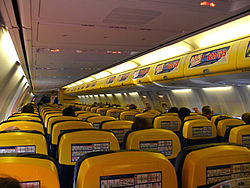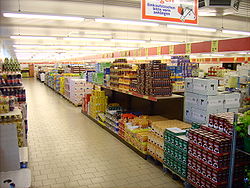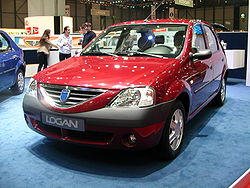- No frills
-
No-frills or no frills is a term used to describe any service or product for which the non-essential features have been removed to keep the price low. The use of the term "frills" refers to a style of fabric decoration. Something offered to customers for no additional charge may be designated as a "frill" - for example, free drinks on airline journeys, or a radio installed in a rental car.[1] No-frills businesses operate on the principle that by removing luxurious additions, customers may be offered lower prices.[2] Frills or tassles on a carpet are not necessary but make the rug look fancy. Frills on any goods are not necessary but are a luxury. No frills means to live without certain luxuries.
Common products and services for which no-frills brands exist include airlines, supermarkets, vacations and vehicles.
Contents
No-frills airlines
No-frills airlines are airlines that offer low fares but eliminate all non - essential services, such as complimentary drinks snacks, in - flight entertainment systems, business-class seating etc. A no-frills airline will typically cut overheads by flying from more remote airports (with lower access charges) and by using one single type of aircraft.[2] Aircraft cabin interiors may be fitted out with minimum comforts, dispensing with luxuries such as seat-back video screens, reclining seats and blinds; some airlines choose to carry advertising inside the cabin to increase revenue.[3]
Some airlines also extend the definition of "frills" to include standard services and conveniences; for example, a no-frills airline may charge passengers an additional fee for carrying luggage,[4] using the airport check-in desk,[5] using wheelchairs[6] or even for using the toilet.[7]
No-frills holiday
No-frills holidays (vacations in American English) are holidays which, like no-frills airlines, do not include unnecessary services such as:
- in-flight meals
- travel representatives
- transfers between the airport and the hotel
- entertainment
- luxury accommodation
Such holidays usually have a simple fare scheme, in which fares typically increase during peak seasons, and also as more people sign up for the holiday. This rewards early reservations, and is known as "yield management".
Examples of no-frills holiday companies are:
- Just, part of the Thomson/TUI group
- Qbic Low Cost Design Hotels
No-frills supermarkets
No-frills supermarkets are recognisable by their store design and business model.
- They do not decorate aisles or even fill shelves. Instead, pallets of the products on offer are simply parked alongside the aisles, and customers picking up products will gradually empty them. When all items on a pallet have been sold, they are replaced. Prices are given on plain labels.
- Queueing at the checkout is relatively common, as staffing levels reflect average demand rather than peak demand. At actual peak times, customers often have to wait.
- Shopping bags are charged for, as they are seen as a frill. Thus many shoppers put their shopping in the old cardboard boxes that the products came in, put it directly in their trolleys, re use old bags, or buy shopping bags at a low fee. Some low cost stores (such as Kwik Save in the United Kingdom) have abandoned this policy due to complaints from customers.
- They work on the principle that in most supermarkets, 20% of products on sale account for 80% of what people buy. Therefore, they only stock the most commonly sold products.
- They only take cash and debit cards (although this has changed in many stores over the years due to the high usage of credit cards).
- They only open at peak times i.e. 9 am to 6 pm Monday to Saturday, although a few stores are 24hrs.
- They often do not serve branded items, except in the case of special purchases, which are almost always at a discounted price. Instead, they sell generic or private label products.
- The shopping carts have a coin-operated slot, to ensure that the trolleys are kept on site.
- They usually lack butcher, bakery and deli counters.
- Staff (or even the managers) sometimes do the cleaning.
- Must bag your own groceries
- No in-store background music, although some use Satellite Radio.
Examples of no-frills supermarkets are:
- Bottom Dollar Food (United States).
- Save-A-Lot (United States).
- Colruyt (Belgium), (France), (Luxembourg), (Netherlands).
- Lidl (Austria, Belgium, Croatia, Czech Republic, Denmark, Finland, France, Germany, Greece, Hungary, Ireland, Italy, Netherlands, Poland, Portugal, Slovakia, Slovenia, Spain, Sweden, and United Kingdom).
- Aldi (Australia, Austria, Belgium, Denmark, France, Germany, Greece, Hungary, Ireland, Luxembourg, Netherlands, Poland, Portugal, Slovenia, Spain, Switzerland, United States, and United Kingdom).
- Franklins (also sells the "No Frills" generic product range) (Australia)
- Rite Price (sell low/out of code and discontinued lines) (Australia)
- Food Basics, a subsidiary of A&P (United States)
- Food Basics, a subsidiary of A&P Canada, formerly owned by A&P, but sold to Metro Inc. in 2005 (Canada)
- Price Chopper, a subsidiary of Sobeys (Canada)
- Maxi, a subsidiary of Loblaw Companies (Canada)
- No-Frills, a subsidiary of Loblaw Companies (Canada).
- Super C, a division of Metro Inc. based in Québec.
- Biedronka, a subsidiary of Jerónimo Martins (Poland)
- Bónus (Iceland).
- Poundland (United Kingdom).
- Netto (Denmark, France, Germany, United Kingdom, Sweden, Poland, Lanzarote)
- REMA 1000 (Norway, Denmark, Sweden, Slovakia).
- Cassa, a subsidiary of the K-Kauppa chain (Finland).
- Alepa, a subsidiary of the S-market chain) (Finland).
- Denner (Switzerland) used to be a no-frills retailer, but has started polishing its image.
- Pak'n Save (New Zealand)
- Dia* (Spain, Greece, Turkey, Brazil, China, Argentina, Portugal)
- Minipreço* (Portugal)
- Ed* (France)
- Usave, a subsidiary of the Shoprite chain (South Africa, Angola, Ghana, Malawi, Swaziland and Namibia)
- Dia, Minipreço and Ed are all part of the Dia Group, which is in turn part of the Carrefour Group.
- Wilkinson (UK)
- WinCo Foods, an employee owned supermarket in Washington, Idaho, Nevada, Oregon, and California in the USA which offers low prices on generic and namebrand products.
No-frills automobiles
In the United States, a no-frills automobile model typically has a minimum of convenience equipment, a less powerful engine and spartan trim.
Frequently, these models represent the lowest-priced version of a larger selection of more lavishly equipped and trimmed models of that same car. Often, the less-expensive models are sold with a manual transmission and have a shorter options list.
One of the more famous no-frills cars was the Studebaker Scotsman, which was on sale from 1957 to 1958. These cars came with a low-grade cloth-trimmed front seat and contained only a driver's side sunvisor, no door armrests and painted trim (in lieu of chrome trim); even routine convenience items, such as a cigarette lighter and dome light were deleted. Buyers were allowed to buy only a low-cost heater and a few other trim and convenience items from a short options list; a radio was not offered as an option on this model (unlike Studebaker's more expensive models).
During the 1960s and early 1970s, American automakers offered several trim levels of full-sized models (each having a different name), with a price-leading no-frills versions. Examples included the Chevrolet Biscayne, Ford Custom 500, and Plymouth Fury I. While ostensibly targeted toward fleet buyers and business customers where luxury is not a concern, these cars were also available to private customers.
During the gasoline crisis of the 1970s, many American automakers began offering no-frills models on their compact lines of cars (such as the Ford Pinto MPG, and Plymouth Duster "Feather Duster"). As before, these models usually had spartan trim (vinyl seats with rubber floor covering); fewer convenience items than the more expensive models (i.e. no cigarette lighter); lighter-weight components (such as aluminum on various engine, body and suspension components); and a manual transmission.
Most no-frills cars are sold to fleet buyers, such as taxi companies or police departments. However, these models are generally available to cost-conscious private customers whose primary concerns were price, fuel economy and basic low-cost transportation.
The concept of a no-frills car in the European market was common in the fifties with cars such as the Ford Abeille or the Citroën ID Normale. The Dacia Logan is a remarkable example of a recent no-frills car in Europe. Another example is Fiat Albea.
In Argentina and Brazil, the no-frills category takes a considerable share of the new car market. Costs cuts in base versions are listed, but not limited to:
- Very little or no soundproofing
- Low quality plastics
- Substitution of rubber on the dashboard to cheaper (rough) plastic
- String-based instead of acceleration-based seatbelt retraction mechanisms
- No seatbelt height adjustment
- No anti-lock braking systems (except in EU, as EU law requires all new cars to be equipped with ABS) or airbags, however in 2012 in some countries the ABS and airbags will be obligatory.
- No seat height adjustment
- No steering wheel adjustments
- Cheaper paint processes
- Overly facelifted models instead of new generations: Volkswagen Santana, Fiat Palio, Fiat Uno, Volkswagen Kombi, Volkswagen Golf, Chevrolet Corsa
- Cast iron cylinder heads and engine blocks
- No lambda sensor
- Retrofitting old generation components (older, less efficient engines, platforms, dashboard components) on a European designed vehicle: Ford Fiesta, Fiat Idea, Fiat Punto, Chevrolet Meriva, Volkswagen Polo.
- Selling the car with alternative nameplates. i.e.: Saturn Astra sold in Brazil with the Chevrolet Vectra nameplate.
- Marketing old 1980s and 1990s designs, e.g. Volkswagen Golf Mk1 as Volkswagen Citi Golf.
- No lamps on the lateral direction lights or remotion of the lateral direction lights at all
- Single-piece plastic bumpers; any grills are designed by placing indentations on the plastic
- Low-quality springs on the suspension, compensated by a taller and harder adjustment
- Less maintenance on the tools used to build the vehicles
- No side-mirror heaters
- Smaller and more restrictive catalytic converters
While cost cuts are clearly visible in nearly any Mercosur car, the most aggressive form of no-frills cars available are the supermini and city cars sold at the Mercosur markets, notably the Chevrolet Celta, Chevrolet Corsa, Fiat Uno, Fiat Palio, Ford Ka and Volkswagen Gol. Those cars tend to be noisy and feature cost cuttings like:
- No lock on the fuel cap
- Elimination of nearly all process to polish or finish the molded plastic parts
- Substitution of black plastics by cheaper gray ones, even on unpainted bumpers
- 1-liter engine (due to Brazil's taxation according the engine displacement)
- Ultra-short gearbox, with the 5th gear scaled as the 4th gear of a regular 1.3 vehicle.
- Cheaper mufflers
- Thinner wheels (e.g. 145/70 R13 tires)
- Instrument panel only with speedometer, fuel gauge and warning lamps
- Two-point seatbelts or non-retractable three-point seatbelts for the rear passengers
- No rear headrests
- Fixed rear windows
- No anti-roll bar
- Smaller and thinner disk brakes, often non-ventilated
- Very thin and low quality trunk carpet
- No side carpets inside of the trunk and any other trunk carpet
- No cigarette lighter
- Less plastic interior coverings, including the covers of the front seat's rails
- No rear window wiper
- No rear window defogger
- Only two-speeds for the internal fan
- Cheaper, noisier internal fan
- Cheaper, imprecise mechanisms for setting the internal ventilation direction and heating.
Other no-frills companies
Other examples of no-frills companies includes, but not limited to: Cinemas (easyCinema), bus companies (easyBus, Megabus (North America), Megabus (United Kingdom), Eastern), food ranges (Tesco Value, Wal-mart/Asda SmartPrice), mobile phone companies (easyMobile, Telmore) and hotels (Stayorange, easyHotel, citizenM, Hotel Formule 1, Holiday Inn, Motel 6, Tune Hotels, Dodo Hotel, Retail Heating Oil No Frills Oil).
References
- ^ "frill (n), frilly (adj)". Cambridge Advanced Learner's Dictionary. Cambridge University Press. 2008. http://dictionary.cambridge.org/define.asp?key=31300&dict=CALD. Retrieved 2008-08-30.
- ^ a b "Illustrative example 1.3: Ryanair". Introduction to Marketing Concepts. p. 13. ISBN 0750659955.
- ^ "Ryanair 'to cut frills further'". BBC News. 2004-02-15. http://news.bbc.co.uk/1/hi/business/3489761.stm. Retrieved 2008-08-30.
- ^ McGrath, Ginny (2007-08-04). "EasyJet scraps free baggage allowance". London: The Times. http://www.timesonline.co.uk/tol/travel/news/article2194820.ece. Retrieved 2008-08-30.
- ^ Skidmore, Jeremy (2008-02-21). "Warning over airlines' hidden extras". London: Daily Telegraph. http://www.telegraph.co.uk/travel/739205/Warning-over-airlines'-hidden-extras.html. Retrieved 2008-08-29.
- ^ "Court rules that Ryanair was wrong to charge disabled passengers for providing wheelchairs". You and Yours. BBC Radio 4. http://www.bbc.co.uk/radio4/youandyours/yy_20040130.shtml. Retrieved 2008-08-29.
- ^ "Ryanair toilet charge is no joke, insists O'Leary". London: The Guardian. 2009-03-05. http://www.guardian.co.uk/business/2009/mar/05/ryanair-toilet-charge. Retrieved 2010-05-20.
External links
Categories:
Wikimedia Foundation. 2010.



